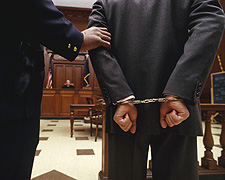Apprendi v. New Jersey, 530 U.S. 466 (2000), is a landmark United States Supreme Court decision with regard to aggravating factors in crimes. The Court ruled that the Sixth Amendment right to a jury trial, incorporated against the states through the Fourteenth Amendment, prohibited judges from enhancing criminal sentences beyond statutory maxima based on facts other than those decided by the jury beyond a reasonable doubt. The decision has been a cornerstone in the modern resurgence in jury trial rights. As Justice Scalia noted in his concurring opinion, the jury-trial right "has never been efficient; but it has always been free."
Gregg v. Georgia, Proffitt v. Florida, Jurek v. Texas, Woodson v. North Carolina, and Roberts v. Louisiana, 428 U.S. 153 (1976), reaffirmed the United States Supreme Court's acceptance of the use of the death penalty in the United States, upholding, in particular, the death sentence imposed on Troy Leon Gregg. Referred to by a leading scholar as the July 2 Cases and elsewhere referred to by the lead case Gregg, the Supreme Court set forth the two main features that capital sentencing procedures must employ in order to comply with the Eighth Amendment ban on "cruel and unusual punishments". The decision essentially ended the de facto moratorium on the death penalty imposed by the Court in its 1972 decision in Furman v. Georgia 408 U.S. 238 (1972).
Roper v. Simmons, 543 U.S. 551 (2005), was a landmark decision in which the Supreme Court of the United States held that it is unconstitutional to impose capital punishment for crimes committed while under the age of 18. The 5–4 decision overruled Stanford v. Kentucky, in which the court had upheld execution of offenders at or above age 16, and overturned statutes in 25 states.
Oregon v. Guzek, 546 U.S. 517 (2006), was a decision by the Supreme Court of the United States, which ruled that the Eighth Amendment to the United States Constitution does not grant criminal defendants facing the death penalty the right to introduce new evidence of their innocence during sentencing that was not introduced during trial. Accordingly, states could constitutionally exclude such evidence from the sentencing phase of a capital trial.
Johnny Paul Penry is a Texas prisoner serving three consecutive sentences of life imprisonment without parole for rape and murder. He was on death row between 1980 and 2008, and his case generated discussion about the appropriateness of the death penalty for offenders who are thought to be intellectually disabled.
Fortunato Pedro "Pete" Benavides is a Senior United States Circuit Judge of the United States Court of Appeals for the Fifth Circuit. His chambers are in Austin, Texas.
Walton v. Arizona, 497 U.S. 639 (1990), was a United States Supreme Court case that upheld two important aspects of the capital sentencing scheme in Arizona — judicial sentencing and the aggravating factor "especially heinous, cruel, or depraved" — as not unconstitutionally vague. The Court overruled the first of these holdings in Ring v. Arizona, 536 U.S. 584 (2002). The second of these holdings has yet to be overturned.
Strickland v. Washington, 466 U.S. 668 (1984), was a decision by the Supreme Court of the United States that established the standard for determining when a criminal defendant's Sixth Amendment right to counsel is violated by that counsel's inadequate performance.
Penry v. Lynaugh, 492 U.S. 302 (1989), sanctioned the death penalty for mentally retarded offenders because the Court determined executing the mentally retarded was not "cruel and unusual punishment" under the Eighth Amendment. However, because Texas law did not allow the jury to give adequate consideration as a mitigating factor to Johnny Paul Penry's intellectual disability at the sentencing phase of his murder trial, the Court remanded the case for further proceedings. Eventually, Penry was retried for capital murder, again sentenced to death, and again the Supreme Court ruled, in Penry v. Johnson, that the jury was not able to adequately consider Penry's intellectual disability as a mitigating factor at the sentencing phase of the trial. Ultimately, Penry was spared the death penalty because of the Supreme Court's ruling in Atkins v. Virginia, which, while not directly overruling the holding in "Penry I", did give considerable negative treatment to Penry on the basis that the Eighth Amendment allowed execution of the mentally retarded.
Wiggins v. Smith, 539 U.S. 510 (2003), is a case in which the United States Supreme Court spelled out standards for "effectiveness" in the constitutional right to legal counsel guaranteed by the Sixth Amendment. Previously the court had determined that the Sixth Amendment included the right to "effective assistance" of legal counsel, but it did not specify what constitutes "effective", thus leaving the standards for effectiveness vague. In Wiggins v. Smith, the court set forth the American Bar Association Guidelines for the Appointment and Performance of Defense Counsel in Death Penalty Cases Guideline 11.8.6.(1989), as a specific guideline by which to measure effectiveness and competence of legal counsel.
In criminal law, a mitigating factor, also known as extenuating circumstances, is any information or evidence presented to the court regarding the defendant or the circumstances of the crime that might result in reduced charges or a lesser sentence. Unlike a legal defense, it cannot lead to the acquittal of the defendant. The opposite of a mitigating factor is an aggravating factor.

Bigby v. Dretke 402 F.3d 551, the U.S. Court of Appeals for the Fifth Circuit heard a case appealed from the United States District Court for the Northern District of Texas on the issue of the instructions given to a jury in death penalty sentencing. The decision took into account the recent United States Supreme Court decisions concerning the relevance of mitigating evidence in sentencing, as in Penry v. Lynaugh.
The Capital Jury Project (CJP) is a consortium of university-based research studies on the decision-making of jurors in death penalty cases in the United States. It was founded in 1991 and is supported by the National Science Foundation (NSF). The goal of the CJP is to determine whether jurors' sentencing decisions conform to the constitution and do not reflect the arbitrary decisions the United States Supreme Court found when it ruled the death penalty unconstitutional in Furman v. Georgia. That 1972 Supreme Court decision eliminated the death penalty which was not reinstated until Gregg v. Georgia in 1976.
United States criminal procedure derives from several sources of law: the baseline protections of the United States Constitution, federal and state statutes; federal and state rules of criminal procedure ; and state and federal case law. Criminal procedures are distinct from civil procedures in the US.
Payne v. Tennessee, 501 U.S. 808 (1991), was a United States Supreme Court case which held that testimony in the form of a victim impact statement is admissible during the sentencing phase of a trial and, in death penalty cases, does not violate the Cruel and Unusual Punishment Clause of the Eighth Amendment. Payne narrowed two of the Courts' precedents: Booth v. Maryland (1987) and South Carolina v. Gathers (1989).

The Supreme Court of the United States handed down nineteen per curiam opinions during its 2009 term, which began on October 5, 2009, and concluded October 3, 2010.
The United States Constitution contains several provisions related to criminal sentencing.
Smith v. Spisak, 558 U.S. 139 (2010), was a United States Supreme Court decision on the applicability of the Antiterrorism and Effective Death Penalty Act of 1996. It further examined issues of previous court decisions on jury instructions and the effectiveness of counsel.
Kansas v. Carr, 577 U.S. ___ (2016), was a case in which the Supreme Court of the United States clarified several procedures for sentencing defendants in capital cases. Specifically, the Court held that judges are not required to affirmatively instruct juries about the burden of proof for establishing mitigating evidence, and that joint trials of capital defendants "are often preferable when the joined defendants’ criminal conduct arises out of a single chain of events". This case included the last majority opinion written by Justice Antonin Scalia before his death in February 2016.
Cone v. Bell, 556 U.S. 449 (2009), was a case in which the United States Supreme Court held that a defendant was entitled to a hearing to determine whether prosecutors in his 1982 death penalty trial violated his right to due process by withholding exculpatory evidence. The defendant, Gary Cone, filed a petition for postconviction relief from a 1982 death sentence in which he argued that prosecutors violated his rights to due process under the Fourteenth Amendment by withholding police reports and witness statements that potentially could have shown that his drug addiction affected his behavior. In an opinion written by Justice John Paul Stevens, the Supreme Court held that Cone was entitled to a hearing to determine whether the prosecution's failure to disclose exculpatory evidence violated Cone's right to due process; the Court noted that "the quantity and the quality of the suppressed evidence lends support to Cone’s position at trial that he habitually used excessive amounts of drugs, that his addiction affected his behavior during his crime spree". In 2016, Gary Cone died from natural causes while still sitting on Tennessee's death row.








